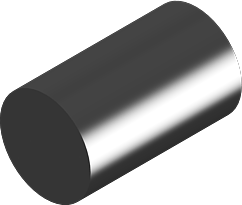Inconel 601
View AMS Numbers >Nickel Inconel 601 is a member of the austenitic nickel-chromium based super alloys. It is used for applications that require extremely high resistance to heat, and very high resistance to oxidation and corrosion at higher temperatures. It has excellent mechanical properties and is easily workable with standard procedures.
Due to its plethora of positive properties, it finds use in harsh environments in different industry applications, especially in places where it is repeatedly exposed to a wide temperature range and in the presence of corrosives, such as acids.
Tech Steel & Materials offers Nickel Inconel 601 in 2 sub-type specifications, each in multiple and customized shapes/forms:
We offer a fully customized line of tube drawing and seamless tubing for Nickel 601. To learn more about our custom tubing services click here: Custom Tubing for Your Unique Application
The Composition (%) of Nickel Inconel 601
The composition of the particular alloy is the following:
| Nickel | Chromium | Iron | Aluminum | Carbon | Manganese | Sulfur | Silicon | Copper |
| 58%-63% | 21%-25% | Remainder | 1%-1.7% | 0.10% max | 1% max | 0.015% max | 0.50% max | 1% max |
Fabrication and Working Instructions
The Inconel 601 alloy can be formed, machined and welded by standard procedures. That said, it is strongly recommended to clean it from oil or paint before heating, as with every other alloy with high nickel content.
A low-sulfur atmosphere is also a must, and also fuels which are very low in sulfur. Even though it is resistant to oxidation, Inconel 601 should be heated in furnaces with a slightly reducing atmosphere.
Strengthening with heat treatment doesn’t work on this alloy. Instead, use of cold work and an annealing treatment is recommended for achieving different ranges of strength and hardness. The Inconel 601 alloy is annealed at 2100°F (1149°C) and then cooled rapidly through the 1000 to 1400°F (540 to 760°C) temperature range to prevent thermal cracking.
Rapid cooling also has no effect on the mechanical properties of Inconel 601, but rapid cooling is still recommended for pickled material in order to avoid sensitization.
Pickling, on the other hand, must be used to produce bright surfaces on parts that have been previously heated, due to the aluminum and chromium content of the Inconel 601 alloy.
Mechanical and Physical Properties of Nickel Inconel 601
Nickel Inconel 601 has good mechanical strength, but its mechanical property changes depending on the form of the material. According to the manufacturer, the optimal temperature for this alloy is 1004°F (540°C) and above for solution-treated condition, and 1004°F (540°C) and below for annealed condition. Being used primarily in high-temperature applications, the Inconel Alloy 601 can retain its high tensile properties at higher temperatures, and it is not embrittled by extended exposure.
| Mechanical Properties | Imperial | Metric |
| Tensile strength (solution annealed, room temperature) | 110000 psi | 760 MPa |
| Yield strength (solution annealed, room temperature) | 65300 psi | 450 MPa |
| Elongation at break | 42% | 42% |
Finally, the physical properties of Inconel 601 can be summarized in the following:
| Density | 8.11 Mg/m3 (0.293 lb/in3) |
| Melting Range | 2480-2571°F (1360-1411°C) |
| Specific Heat | 70°F – 0.107 Btu/lb-°F (21°C – 448 J/kg-°C) |
| Permeability at 200 oersted | |
| 76°F – 1.003 (24°C – 1.003) | |
| -109°F – 1.004 (-78°C – 1.004) | |
| -320°F – 1.016 (-196°C – 1.016) | |
| Curie Temperature | <-320°F (<-196°C) |
Applications and Common Use Of Nickel Inconel 601
- High-temperature applications in the automotive industry and aerospace – turbocharger rotors and seals (notable use is Mazda RX-7 third gen), rotary engines (Norton motorcycles), Formula 1 and NASCAR exhaust systems;
- High-temperature applications in aerospace – gas turbine blades and containment rings, seals and combustors, jet engine igniters, combustion-can liners, and diffuser assembles;
- Thermal-processing equipment – baskets, trays, and fixtures for annealing, carburizing, carbonitriding, nitriding for industrial-heating applications, and in radiant tubes, muffles, retorts, flame shields, strand-annealing tubes, woven-wire conveyor belts, and electrical resistance heating elements in industrial furnaces;
- Chemical-processing – insulating cans in ammonia reformers and equipment for nitric acid production;
- Petrochemical processing – catalyst generators and air preheaters;
- Pollution-control applications – combustion chambers in solid-waste incinerators;
- Power-generation field – superheater tube supports grid barriers and ash handling
Other Aspects and Advantages
The nickel alloy has a high degree of metallurgical stability, and it has a complete absence of embrittling intermetallic phases thanks to its internal microstructure.
The high content of nickel and chromium make the Inconel 601 alloy extremely resistant to high-temperature corrosion mechanisms, with resistance to oxidation of up to 2200°F (1200°C).
Unique among similar alloys, it also has resistance to oxide spalling under cyclic thermal conditions. It forms a protective oxide coating that resists scaling even after repeated exposure to temperature. This property of the alloy is linked to the high amounts of nickel and chromium, and also the presence of aluminum, all of which form an extremely protective oxide film on the material.
Nickel Inconel 601 alloy has good resistance to carburization and carbonitriding environments.



 Tech Steel & Materials
Tech Steel & Materials